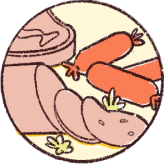You’ve just arrived in the 1950s in your time machine. Mr Cooke, the owner of the local general store, is waiting for you behind this door.
Are you ready to go inside?
Mrs Gamble takes the bus home, leaving her grocery list with Mr Cooke to fetch.
She also leaves her housekeeping allowance with Mr Cooke as payment.
Back in the 1950s, the husband in each family controlled all of the money.
Husbands gave their wives a housekeeping allowance: pocket money to shop for the whole family. Wives were expected to take care of the home.
This money is what Mrs Gamble just gave to Mr Cooke to pay for her order.

Mrs Cooke’s knee is playing up again, so she had to stay home.
I don’t like to keep my customers waiting!
Get to work before I dock your pay.”
Yes, Mr. Cooke!See the little girl in the store?
Her name is Lucy Figg.
Lucy’s Mum has asked her to pick up some extra fabric for sewing her own dresses. Will you help her collect her fabric?
I’m on the job!While you collect Lucy’s fabric, click around the shelves to discover what else the grocer has to sell.
Lets get startedCollect a roll of fabric for Lucy.
Click around the shelves to discover what else the grocer has to sell.








For this task, click the coins to take the correct amount of Lucy’s money.
“Thank you!”
It’s the chicken man, here to deliver the eggs!
Click on the chicken man to hear some local gossip.
“Goodness, gracious me. There’s been a fox eating everyone’s chickens. Eggs will be very popular this week, because family hens won’t be laying their own. That’s why I brought you double the eggs you usually order.



















